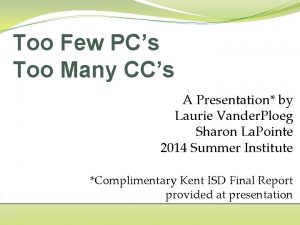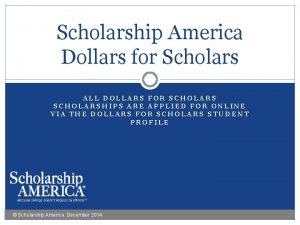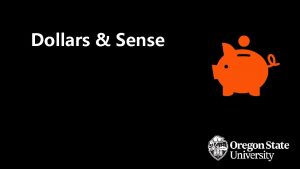Too Many Vehicles Chasing Too Few Dollars v









- Slides: 9


Too Many Vehicles Chasing Too Few Dollars v The limousine services industry continues to face many challenges, which is why total gross limo operator industry revenues for 2015 (the latest data) decreased a very significant 32% from 2014’s $3. 3 billion to 2015’s $2. 5 billion. v With an increase of 555 additional operators (limousine/chauffeured and motorcoach/ charter and tours), from 12, 106 during 2014 to 12, 661 during early 2016, there were more operators chasing fewer revenue dollars. v The decline in revenues resulted in 4, 000 fewer chauffeured vehicles in service during 2015, or 104, 000, compared to 108, 000 during 2014.

The Business Behind the Wheel v Despite a significant decline in total 2015 industry revenues, LCT’s 2016– 2017 Fact Book reported that 63% of operators said their 2015 revenues increased, 22% said they decreased and 16% said they were the same. v The average operator’s profit margin increased for the third consecutive year, from 17% for 2012 to 19% for 2013 to 21% for 2014 to 24% for 2015. v The largest percentage (21%) of operators had 2015 gross revenues between $1 million and $4, 999. Among small operators, 35%, less than $100, 000; medium operators, 46%, $1 million–$4, 999; and large operators, 45%, $10 million or more.

On the Run v According to survey results from LCT’s 2016– 2017 Fact Book, 25% of limousine companies’ corporate revenues were generated from affiliated partners (also known as farmins) and 17% of operators’ services were “farmed out” to affiliates. v Small operators averaged 126 runs/reservations per month, 521 for medium operators and 6, 253 for large operators. Two-thirds of all reservations were generated from the company’s Website and 55% from industry association directories. v No surprise that the largest percentage (20%) of limousine operators were located in Middle Atlantic states; followed by 19%, South Atlantic; 18%, Pacific; 12%, East North Central; 9%, New England, 7%, West South Central; and 5%, Mountain.

Tech-Enhanced Trips v Although LCT’s 2016– 2017 Fact Book reported that just 29% of survey respondents had a company-branded mobile app, 48% said they belonged to an integrated app network via an industry technology vendor, such as Limo Anywhere and Limo Alliance. v More than 50% of operators said they were extremely likely (27%) and likely (25%) to join a partnership with mobile app ride providers/competitors in their service area in an attempt to capture more of the on-demand market. v Asked how likely they would join a nationwide app-based chauffeur service, 23% said extremely likely; 17%, likely; 29%, not sure; 16%, unlikely; 14%, not at all likely; and 1%, not familiar with these services.

Competing with TNCs v As noted in the table on page 3, TNCs, or transportation network companies, such as Uber and Lyft, were limousine operators’ biggest business concern, with 35% saying their effect was mostly negative in an LCT February 2016 survey. v Only 7. 3% thought TNCs’ effect was mostly positive; 32. 5%, mixed; and 16%, none. The largest percentage, 39. 2%, said they had lost 10% or less business to TNCs during 2015, with 22. 8% saying none, but 20. 3%, more than 20%. v The effect of TNCs didn’t seem to have had much effect, as 66. 4% of limousine services said they didn’t change their rates and 63. 2% said they bought/planned to buy newer, more expensive vehicles to distinguish their fleets from TNCs’.

Advertising Strategies v However limousine services market, advertise and promote their business, they should emphasize the luxury and “star treatment” of their services compared to TNCs, such as Uber and Lyft. v Promote a Mother’s Day and/or Father’s Day special rate for transporting the entire family to dinner or a family activity to celebrate these occasions. v Promote a discounted fee for a set number of passengers when transported during a late Friday or Saturday night within the city’s adult entertainment district.

New Media Strategies v With the prom season approaching, limousine services should post helpful content on Snapchat, relating to prom safety issues with language and videos that speak to teens, and then re-create the content for posting on Facebook aimed at parents. v Share photos and videos of a “Good Deed Trip, ” when once a month or quarter the limousine service transports a group of seniors from an assisted-living facility on a shopping trip, low-wage workers to and from their job or a military family as a thank you. v Create and post chauffeurs/drivers’ interesting back stories in the form of a video presentation that could include an overview of his or her vehicle amenities, unique client stories, most unusual requests, etc.


















